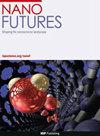Preparation and water flow velocity measurement of a large diameter single-wall carbon nanotube
IF 2.5
4区 材料科学
Q3 MATERIALS SCIENCE, MULTIDISCIPLINARY
引用次数: 2
Abstract
To fill the gap in the measurement of large diameter single-wall carbon nanotube (SWCNT) and further predict the variation rule of mass flux versus diameter, this work measured the water flow velocity and mass flux coefficient in an individual SWCNT with a 3.07 nm diameter. A mechanical method is used to obtain the large diameter SWCNT by removing the internal tube of a double-wall carbon nanotube, and then the water flow velocity through this SWCNT was measured by an electrical method. The water flow velocity of large diameter SWCNT can reach to 146.1 ± 32.5 μm s−1, and the enhancement factor compared with no-slip Hagen–Poiseuille relation is about 14.5. A mass flux coefficient is defined to describe the mass flow ability through SWCNT and calculated by the experiment data. Although the enhancement factor decreased to ∼1/4 of the normal size SWCNT (∼1.5 nm), the mass flux coefficient in the large diameter SWCNT increased efficiently, and which is about 5.7 times to the normal size SWCNT. Based on the above measurement result, a reported simulation result can be revised and then verified to describe the enhancement factor versus diameter, and the mass flux coefficient of the SWCNT can be further predicted. According to the prediction result, in the bulk-like liquid region, the mass flux of an individual SWCNT can reach to maximum when the diameter is around 2.9 nm, which would provide a new idea for the design of the SWCNT-based nanodevices in the future.大直径单壁碳纳米管的制备及流速测量
为了填补大直径单壁碳纳米管(SWCNT)测量中的空白,并进一步预测质量流量随直径的变化规律,本工作测量了直径为3.07nm的单个SWCNT中的水流速度和质量流量系数。使用机械方法通过去除双壁碳纳米管的内管来获得大直径SWCNT,然后通过电学方法测量通过该SWCNT的水流速度。大直径SWCNT的水流速度可达146.1±32.5μm s−1,与无滑移Hagen–Poiseuille关系相比,增强因子约为14.5。定义了质量流量系数来描述通过SWCNT的质量流动能力,并根据实验数据进行了计算。尽管增强因子降低到正常尺寸SWCNT的~1/4(~1.5nm),但大直径SWCNT中的质量通量系数有效增加,约为正常尺寸SWNT的5.7倍。基于上述测量结果,可以对已报道的模拟结果进行修正,然后对其进行验证,以描述增强因子与直径的关系,并可以进一步预测SWCNT的质量通量系数。根据预测结果,在块状液体区域,当直径在2.9nm左右时,单个单壁碳纳米管的质量通量可以达到最大值,这将为未来基于单壁碳管的纳米器件的设计提供新的思路。
本文章由计算机程序翻译,如有差异,请以英文原文为准。
求助全文
约1分钟内获得全文
求助全文
来源期刊

Nano Futures
Chemistry-General Chemistry
CiteScore
4.30
自引率
0.00%
发文量
35
期刊介绍:
Nano Futures mission is to reflect the diverse and multidisciplinary field of nanoscience and nanotechnology that now brings together researchers from across physics, chemistry, biomedicine, materials science, engineering and industry.
 求助内容:
求助内容: 应助结果提醒方式:
应助结果提醒方式:


